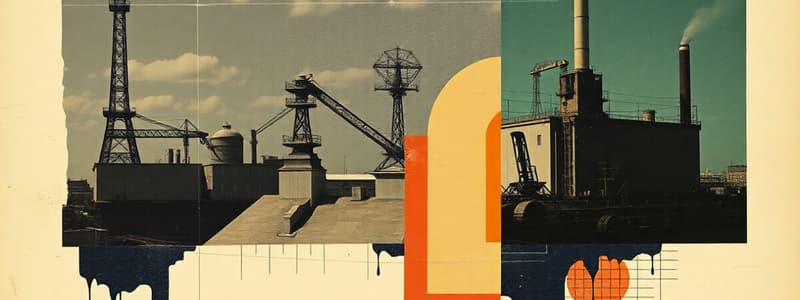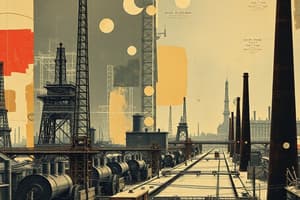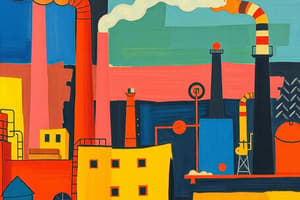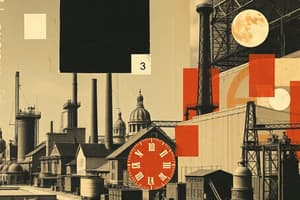Podcast
Questions and Answers
Which natural resources were crucial for the development of industries in Britain?
Which natural resources were crucial for the development of industries in Britain?
- Coal and iron ore (correct)
- Sand and gravel
- Wood and clay
- Gold and silver
Which factor did NOT contribute to Britain's industrialization?
Which factor did NOT contribute to Britain's industrialization?
- Access to raw materials from colonies
- Technological advancements
- Development of the factory system
- Decline of the middle class (correct)
The Commercial Revolution did not impact the growth of industries in Britain.
The Commercial Revolution did not impact the growth of industries in Britain.
False (B)
The Industrial Revolution was primarily focused on agriculture and did not involve technological advancements.
The Industrial Revolution was primarily focused on agriculture and did not involve technological advancements.
Name one technological innovation that revolutionized production processes during the Industrial Revolution in Britain.
Name one technological innovation that revolutionized production processes during the Industrial Revolution in Britain.
What was the primary system of labor that emerged during the Industrial Revolution in Britain?
What was the primary system of labor that emerged during the Industrial Revolution in Britain?
The development of a network of __________, roads, and railways facilitated transportation during the Industrial Revolution.
The development of a network of __________, roads, and railways facilitated transportation during the Industrial Revolution.
Match the following factors with their descriptions:
Match the following factors with their descriptions:
The _______ and the Scientific Revolution inspired curiosity and innovation in Britain.
The _______ and the Scientific Revolution inspired curiosity and innovation in Britain.
Which of the following factors did NOT contribute to Britain's industrial development?
Which of the following factors did NOT contribute to Britain's industrial development?
Match the following characteristics of the Industrial Revolution with their descriptions:
Match the following characteristics of the Industrial Revolution with their descriptions:
Which invention was NOT a key advancement during the Industrial Revolution?
Which invention was NOT a key advancement during the Industrial Revolution?
Britain's sophisticated financial system included the establishment of banks and insurance companies.
Britain's sophisticated financial system included the establishment of banks and insurance companies.
The division of labor increased production efficiency during the Industrial Revolution.
The division of labor increased production efficiency during the Industrial Revolution.
What was one result of the Enclosure Movement in Britain?
What was one result of the Enclosure Movement in Britain?
What economic transition characterized Britain during the Industrial Revolution?
What economic transition characterized Britain during the Industrial Revolution?
What was one of the key drivers of the Industrial Revolution in Britain?
What was one of the key drivers of the Industrial Revolution in Britain?
The Industrial Revolution in Britain led to a decrease in economic growth.
The Industrial Revolution in Britain led to a decrease in economic growth.
Name one natural resource that was heavily exploited during the Industrial Revolution in Britain.
Name one natural resource that was heavily exploited during the Industrial Revolution in Britain.
The migration of people from rural areas to urban centers during the Industrial Revolution is known as __________.
The migration of people from rural areas to urban centers during the Industrial Revolution is known as __________.
Match the following consequences of the Industrial Revolution with their descriptions:
Match the following consequences of the Industrial Revolution with their descriptions:
Which infrastructure development played a crucial role in the Industrial Revolution?
Which infrastructure development played a crucial role in the Industrial Revolution?
Social reforms were a response to the working conditions during the Industrial Revolution.
Social reforms were a response to the working conditions during the Industrial Revolution.
What was a key factor that contributed to the rise of the labor movement in Britain during the Industrial Revolution?
What was a key factor that contributed to the rise of the labor movement in Britain during the Industrial Revolution?
What was the impact of the Industrial Revolution on social inequality?
What was the impact of the Industrial Revolution on social inequality?
The Industrial Revolution had no significant impact on the environment.
The Industrial Revolution had no significant impact on the environment.
What role did technological innovation play during the Industrial Revolution?
What role did technological innovation play during the Industrial Revolution?
The reliance on _______ and other fossil fuels during the Industrial Revolution contributed to air and water pollution.
The reliance on _______ and other fossil fuels during the Industrial Revolution contributed to air and water pollution.
Match the following changes with their descriptions:
Match the following changes with their descriptions:
What was one of the key factors that fueled the Industrial Revolution in Britain?
What was one of the key factors that fueled the Industrial Revolution in Britain?
The invention of the steam engine had no significant impact on transportation during the Industrial Revolution.
The invention of the steam engine had no significant impact on transportation during the Industrial Revolution.
What industry was among the first to change significantly during the Industrial Revolution?
What industry was among the first to change significantly during the Industrial Revolution?
The __________ Revolution in Britain led to increased food production and a surplus of labor.
The __________ Revolution in Britain led to increased food production and a surplus of labor.
What social condition emerged as a result of the Industrial Revolution?
What social condition emerged as a result of the Industrial Revolution?
By the mid-19th century, Britain had fallen behind in industrial power compared to other countries.
By the mid-19th century, Britain had fallen behind in industrial power compared to other countries.
What legislative measures were taken to protect workers during the Industrial Revolution?
What legislative measures were taken to protect workers during the Industrial Revolution?
Flashcards
Industrial Revolution
Industrial Revolution
A period of rapid technological advancements and economic growth, starting in Britain in the late 18th century, resulting in widespread social and political changes.
Natural Resources in the IR
Natural Resources in the IR
Natural resources like coal, iron ore, and waterways, crucial for powering industries and transporting goods.
Changes in textile industry
Changes in textile industry
The invention of machines like mechanical looms and spinning machines that increased production and efficiency in the textile industry.
Steam Engine's impact
Steam Engine's impact
Signup and view all the flashcards
Urbanization and its effects
Urbanization and its effects
Signup and view all the flashcards
Government regulation during the IR
Government regulation during the IR
Signup and view all the flashcards
Agricultural Revolution's link to the IR
Agricultural Revolution's link to the IR
Signup and view all the flashcards
Britain's Industrial Dominance
Britain's Industrial Dominance
Signup and view all the flashcards
Factory Conditions
Factory Conditions
Signup and view all the flashcards
Labor Movement
Labor Movement
Signup and view all the flashcards
Technological Innovation
Technological Innovation
Signup and view all the flashcards
Environmental Impact
Environmental Impact
Signup and view all the flashcards
Global Expansion
Global Expansion
Signup and view all the flashcards
Colonial Expansion's Role in Industrial Revolution
Colonial Expansion's Role in Industrial Revolution
Signup and view all the flashcards
Intellectual and Cultural Factors
Intellectual and Cultural Factors
Signup and view all the flashcards
Social and Economic Changes
Social and Economic Changes
Signup and view all the flashcards
Technological Advancements
Technological Advancements
Signup and view all the flashcards
Urbanization
Urbanization
Signup and view all the flashcards
Factory System
Factory System
Signup and view all the flashcards
Division of Labor
Division of Labor
Signup and view all the flashcards
Factors Driving the Industrial Revolution
Factors Driving the Industrial Revolution
Signup and view all the flashcards
Natural Resources during the Industrial Revolution
Natural Resources during the Industrial Revolution
Signup and view all the flashcards
Commercial Revolution and Industrialization
Commercial Revolution and Industrialization
Signup and view all the flashcards
Technological Innovation in the Industrial Revolution
Technological Innovation in the Industrial Revolution
Signup and view all the flashcards
Transportation Infrastructure and Industry Growth
Transportation Infrastructure and Industry Growth
Signup and view all the flashcards
Political Stability and Industrialization
Political Stability and Industrialization
Signup and view all the flashcards
Skilled Labor Force in Industrial Britain
Skilled Labor Force in Industrial Britain
Signup and view all the flashcards
Access to Markets and Industrial Growth
Access to Markets and Industrial Growth
Signup and view all the flashcards
Financial Innovations and Industrial Growth
Financial Innovations and Industrial Growth
Signup and view all the flashcards
Capitalism and the Industrial Revolution
Capitalism and the Industrial Revolution
Signup and view all the flashcards
Exploitation of Natural Resources
Exploitation of Natural Resources
Signup and view all the flashcards
Transportation Revolution
Transportation Revolution
Signup and view all the flashcards
Social Changes and the Industrial Revolution
Social Changes and the Industrial Revolution
Signup and view all the flashcards
Urbanization and the Industrial Revolution
Urbanization and the Industrial Revolution
Signup and view all the flashcards
Economic Growth and the Industrial Revolution
Economic Growth and the Industrial Revolution
Signup and view all the flashcards
Social Stratification and the Industrial Revolution
Social Stratification and the Industrial Revolution
Signup and view all the flashcards
Global Impact of the Industrial Revolution
Global Impact of the Industrial Revolution
Signup and view all the flashcards
Study Notes
The Industrial Revolution in Britain
- Marked a period of rapid technological advancements and economic growth, starting in the late 1700s and continuing into the 1800s.
- Key factors included abundant natural resources (coal, iron ore, waterways), a growing population, and a stable political climate.
- The textile industry was one of the first to undergo significant changes, with inventions like mechanical looms and spinning machines increasing production efficiency.
- Factories and mass production of textiles became common, transforming manufacturing methods.
- The invention of the steam engine revolutionized transportation and industries like mining, manufacturing, and agriculture.
- Steam-powered machinery replaced manual labor, increasing productivity and driving economic growth.
- Urbanization increased as people moved from rural areas to cities in search of work, leading to overcrowding, poor living conditions, and a working class facing harsh conditions and low wages.
- Governments played a role in regulating industries and worker protections, with the Factory Acts of the early 1800s establishing limits on working hours, child labor, and factory conditions.
- By the mid-1800s, Britain became a leading industrial power, driven by manufacturing, trade, and technological innovation.
- The revolution had a lasting impact on the world, shaping modern society and impacting subsequent waves of industrialization in other nations.
Factors Contributing to the Industrial Revolution
- Agricultural Revolution: Increased food production resulted in a labor surplus, driving people to urban centers.
- Natural Resources: Abundant coal and iron ore, easily accessible, fueled the growth of industries.
- Commercial Revolution: Expanding trade and commerce created demand for goods and services, fostering industry growth.
- Technological Innovations: Inventions like the steam engine, spinning jenny, and power loom revolutionized production.
- Transportation Infrastructure: Development of canals, roads, and railways facilitated the movement of goods and raw materials, aiding industry growth.
- Political Stability: Consistent political climate supported economic growth and investment.
- Skilled Labor: A skilled workforce, experienced in craftsmanship and trade, supported industrial progress.
- Access to Markets: Domestic and international markets provided opportunities for trade and export, sustaining industrial growth.
Characteristics of the Industrial Revolution
- Technological Advancements: Rapid innovations in various industries, like steam engines, spinning machinery, and farming tools.
- Urbanization: Massive migration from rural areas to urban centers driven by industrial job opportunities.
- Factory System: Businesses employing large numbers of workers in centralized factories powered by steam engines, leading to mass production.
- Division of Labor: Specialization of tasks, increasing efficiency and productivity.
- Capitalism: Private ownership and market forces; key role of entrepreneurs and investors.
- Exploitation of Natural Resources: Reliance on resources like coal, iron, and water for industrial growth.
- Transportation Revolution: Development of canals, roads, and railways greatly improved the transportation of goods.
Consequences of the Industrial Revolution
- Urbanization: Rapid urbanization led to overcrowding, poor living conditions, and social problems.
- Economic Growth: Increased productivity and wealth for the nation, but also widening wealth disparity.
- Social Stratification: Gap between wealthy industrialists and working class grew, leading to social inequality.
- Labor Movement: Workers organized into trade unions advocating for improved working conditions, wages, and rights.
- Global Impact: Industrialization spread to other countries, increasing globalization and colonization.
- Social Changes: Emergence of a new working class; social unrest and calls for reform.
- Environmental Impact: Pollution, deforestation, and depletion of natural resources.
- Technological Innovation: Growth of new technologies shaped production and processes.
Studying That Suits You
Use AI to generate personalized quizzes and flashcards to suit your learning preferences.




